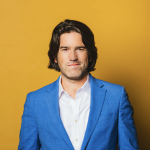Author: Kaihan Krippendorff
Last week I got to spend five and a half hours of Beyond Strategy with one of the most influential strategic thinkers alive today, Gary Hamel. He has written five global best-selling books, published 17 papers in Harvard Business Review, and has taught at London Business School for 30 years. But most importantly, Gary has […]
Last week I got to spend five and a half hours of Beyond Strategy with one of the most influential strategic thinkers alive today, Gary Hamel. He has written five global best-selling books, published 17 papers in Harvard Business Review, and has taught at London Business School for 30 years.
But most importantly, Gary has a gift for introducing new concepts ripe for the time that take hold and change how we think about strategy. For example, if you have ever used the term “core competency,” you have Gary to thank. He introduced the concept in 1990, its adoption surged, and this changed how CEOs, investors, and companies thought about competitive advantage.
In his latest book, Humanocracy: Creating Organizations as Amazing as the People in Them, he appears to diverge from his strategy wheelhouse to focus on people and organization. The book, essentially, shows that the traditional bureaucratic, hierarchical models by which we manage our companies, governments, schools, churches, hospitals, etc., are outdated.
They were built for a time when we needed to manage people almost as we would robots, tightly defining and ensuring accurate compliance with their tasks. But in the age of AI, digital technology, and competitive acceleration, what we need from people is not compliance but creativity. In other words, our organizations were designed to maximize efficiency but today we need structures designed to maximize human contribution.
As he sat with 15 members of our chief strategy officer community, Gary shared that it may seem like a divergence from his strategy career path for him to suddenly pivot to talking about people and organization. But then he explained why. And what he shared will shift your understanding of strategy and potentially enable you to put in place the kind of sustainable competitive advantage that is so hard to come by today.
How Nokia Beat Motorola … then Fell
In the years before Apple and Android, the mobile world was ruled by Motorola, Nokia, and RIM/BlackBerry. In the early and mid-1990s, Motorola was the dominant mobile company. At the time, Gary was advising Nokia, the underdog, and explained to them that “you cannot out-Motorola Motorola.” He was arguing that you cannot overtake the lead position by copying what they do.
Throughout the decade, Nokia introduced a stream of innovations enabled by its young, agile, and decentralized organizational model. Executive Pekka Ala-Pietilä, president of Nokia’s mobile phone business for most of the 90s, likened the company to a jazz band: they improvised as they played together.
This “jazz band” was able to unleash innovations quickly and distribute them better – something that Motorola and other competitors could not keep up with. By 1999, Nokia had overtaken Motorola as the largest handset maker in the world.
But then, things changed. A new CEO, Jorma Ollila, came in and started changing Nokia’s organizational model. In 2004 he initiated a major reorganization, forcing a matrix organizational structure.
There were vertical divisions like business smartphones and feature phones, as well as horizontal units such as marketing. He removed autonomy. Control became centralized. Bureaucratization accelerated. The company started prioritizing controlling costs over value creation. Ala-Pietilä’s jazz band had become a tightly structured marching band.
Nokia subsequently fell, I believe, because they failed to recognize the insight Gary is pointing out today: strategic differentiation is short-lived, but organizational differentiation lasts.
In 2006, Motorola introduced the Razr phone, viewed as a breakthrough innovation in the market, which helped propel it as the most popular mobile phone brand in the world. But Motorola proved to be more “one-hit-wonder” than “hit factory” as it failed to launch market-impacting innovations thereafter.
The results are now well known. Nokia fell to Samsung and Apple. Both Nokia and Motorola fell out of relevance. The lesson is profound.
Differentiating beyond strategy
Strategy matters. While every expert will have their own view on how to define it, strategy is generally about making clear and consistent decisions about things like who we serve, what we offer them, and how we deliver that.
You may have the right strategy today, but in fast-moving markets the sustainment of your success depends not on your current strategy but on your ability to change your strategy. The question is not what your priorities are but how those priorities are set.
Your advantages (if you choose to create and embrace them) stem from three tiers:
Strategy
Business model
Organizational framework
Strategy
Your strategy may change every 1-5 years. It encapsulates key decisions like, as mentioned above, who we serve, what value proposition we fulfill, and how we deliver that. For example, initially Netflix offered DVDs by mail. Then their strategy shifted to movies streamed via the internet.
Business model
Your business model likely changes less frequently than your strategy. When Netflix switched from DVDs to streaming, their business model did not change. They continued to offer membership (unlimited movies for a fixed monthly fee) which proved more attractive to the majority of movie-goers than Blockbuster’s rental fee model.
Adobe shifted its business model from selling licenses to monthly subscriptions and Microsoft did much the same over the last few years, each move playing a critical role in maintaining those companies’ relevance and contributing to the current success of each one.
Organizational framework
But what changes the least frequently, and is most difficult to copy, is your organizational framework: who you hire, how you organize, your culture, and your incentive structure. These factors ultimately determine when and how your business model and strategy will evolve. If your strategy is the wheels on the road and your business model is your steering mechanism, your organizational framework determines who is driving the car.
Sustaining a long-term advantage depends less on strategic and business model decisions you make today and more on the organizational framework that determines who will make those decisions in the future.
Gary outlined several organizations that have adopted differentiated organizational frameworks. Look at Haier, the UK’s NHS, and Holland’s Buurtzorg as examples. To begin putting in place the foundational building blocks that could lead to true sustainable advantage, ask yourself how you can differentiate yourself from your competitors by:
Hiring different kinds of people than they do
Introducing an incentive structure that is different than theirs
Organizing yourself differently (e.g., using internal marketplaces and democratic decision-making rather than hierarchical models)
Adopting cultural values and norms that are unique
Coming up with distinctive answers to as many of these questions as possible will build a unique foundation at the deepest tier (your organizational framework) that will influence your business model and then your strategy, creating a competitive differentiation that can last for decades.
Contact Us at WeSpeak Global and follow us on Twitter
The articles, video and images embedded on these pages are from various speakers and talent.
These remain the property of its owner and are not affiliated with or endorsed by WeSpeak Global.

In life, we get so much input. It is hard to keep up. One piece of advice that I got was to Focus on your skills and on my strengths. We are not meant to be great at everything, but we all have talent. At times we try to improve skills we don’t have a […]

The Survival Guide, originally written for overworked and underappreciated public servants, offers ten checkpoints that signal burnout. After sharing this popular workshop based on the book with audiences filled with clerks, librarians, planners, firefighters, administrators, and many other municipal groups, the private sector came calling. Who cares about Public Servants and a The Survival Guide? Why? Because […]

This has been a year like no other in Defying the odds. It has no doubt tested every ounce of our faith, our resilience and our belief in the future in owning your life. Some of us have already reached our tipping point whilst others are hanging on by a sheer tread. I acknowledge all […]

I’m already working–virtually, of course–with clients on what comes after COVID and what the future may hold. One trend is clear: the “virtualization” of our world has greatly accelerated. Work from home, telemedicine, virtual shopping, distance learning, socializing, exercise: more activities than we might imagine will move to the virtual world during the rest of […]

The Best Employees are the Ones Who Understand the Bigger Picture We often talk about the best leadership qualities, but we should be talking about the best qualities of an employee. The best employees are the ones that know their efforts contribute to something bigger than themselves. They see how their work has an […]

Excited to share the big news that I’ve been talking with many of you about already! The Launch You’ve Been Waiting For. How to Get Results #NoMatterWhat, It turns out there’s actually proven science around how to get results #NoMatterWhat. It’s all too clear that this is still a really tough time for many people […]

When I am working from home, one of my favorite places to go when I need a break is my daughter’s apiary (bee yard). I am absolutely fascinated by these amazing creatures and WHAT YOU CAN LEARN. Between their work ethic and how they function together as a colony, I think I could sit and […]

It is difficult to conceive that 11 months on from National Lock down on 26 March 2020, our tiny business survives and feels strongly that the tide is turning. What a significant time and mighty relief for us, acutely mindful that so many are struggling desperately just to survive. Despite it not being my natural […]
No results available
Our Mission
© All rights reserved 2025. Created using VOXEL THEME